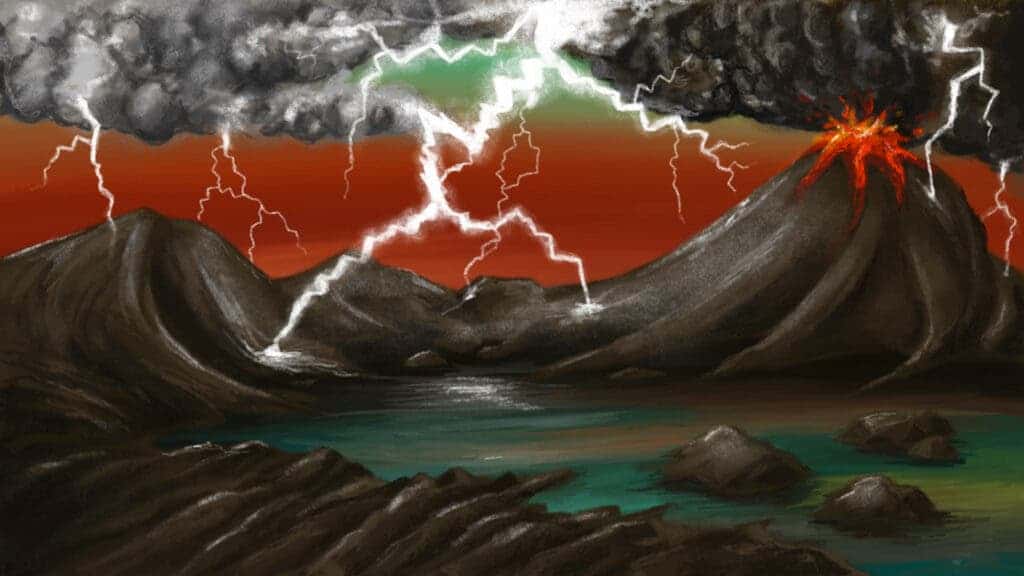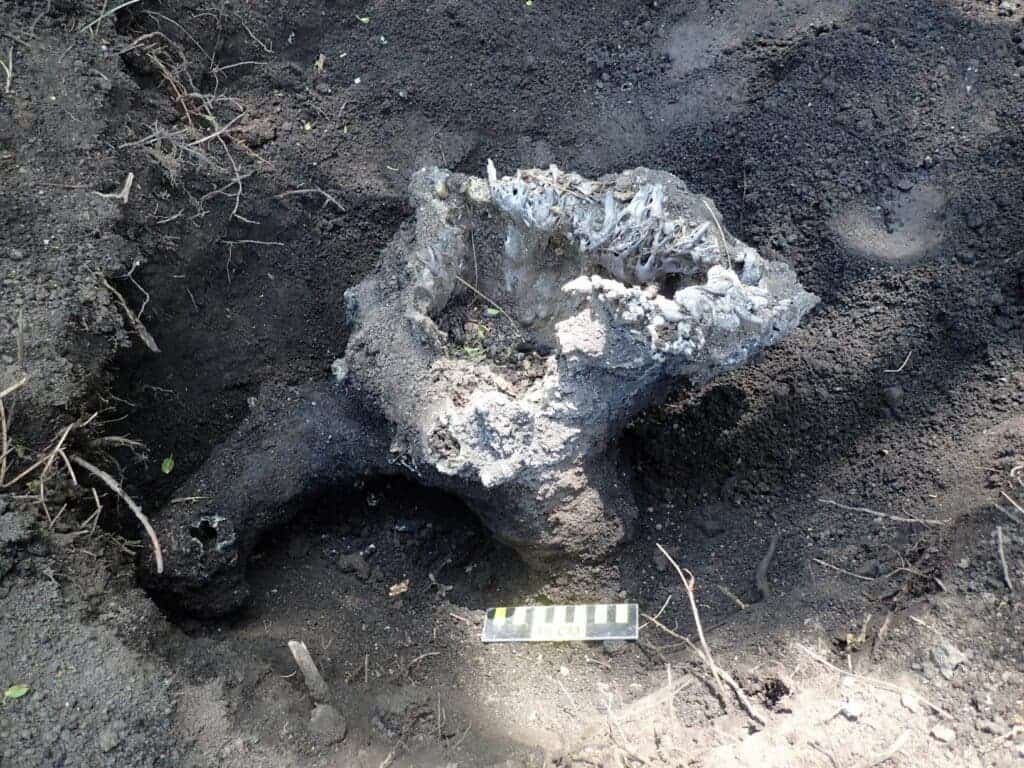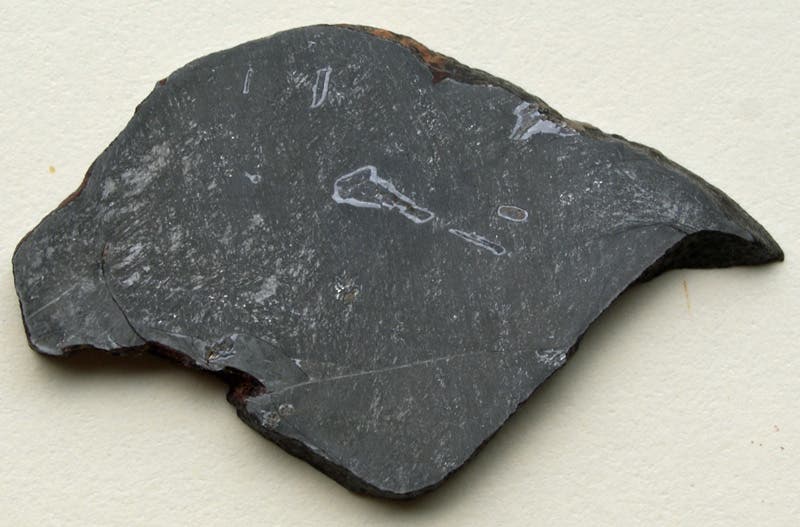Researchers may have found one of the missing puzzle pieces for the emergence of life on Earth. According to a new study, one key mineral for life may have formed thanks to an unexpected phenomenon: lightning.

Rare minerals and life
The emergence of life on Earth required a very specific cocktail of ingredients. You can’t have any of them missing, otherwise, it just doesn’t work — and one of the most troubling ingredients is phosphorous.
The early Earth harbored phosphorous, but it wasn’t useful as it was locked away inside minerals. You’d need bioavailable, reactive phosphorous to form DNA, RNA, and cell membrane lipids. There is one exception where the phosphorous could have come from: the mineral schreibersite.
Schreibersite is a rare mineral. It’s only found in a few places on Earth, like Greenland or the Levant. But this earthly schreibersite formed thanks to carbon-rich rocks, so this couldn’t have worked in the early Earth because there was no life to produce carbon-rich rocks.
“You cannot have schreibersite forming under normal terrestrial conditions, and the few unusual occurrences of it that we find depend on material created by life in the past,” said corresponding author Benjamin Hess from Yale University, in an email. “So then, how do we get it on early Earth?”
There’s one place schreibersite could have come from: outer space. Meteorites are suspected to be a source of the much-needed phosphorous, which is why many researchers believe meteorites “seeded” life on Earth — it’s not that they brought lifeforms along, but rather that they brought the necessary ingredients.
But Hess and colleagues have a different idea. In their new study, they explain that schreibersite can also be formed when lightning strikes specific minerals. In other words, life may have not been seeded on Earth, it may have been sparked.
“Traditionally, the answer has been meteorites because they formed under less oxygen-rich conditions. But in our new work, we are arguing that you can actually get schreibersite through lightning strikes as well which serve to reduce (remove oxygen from) the material they strike.”
The spark of life

Image credits: Stephen Moshier.
When some rocks or soils are hit by lightning, they are transformed into fulgurites. And using a suite of spectroscopic techniques, the team found that schreibersite can form in fulgurites.
It’s not the first time schreibersite was discovered in fulgurites. Previous research has linked it with lightning. But this is the first time that lightning strikes have been suggested as a widespread mechanism, Hess says.
“The previous reports of schreibersite in other fulgurites was actually encouraging because it indicates that this isn’t a strange one-off event. It provides more bite to the new model and my estimates of how much schreibersite would have formed,” he adds.
The team estimated the amount of schreibersite that might have been produced by each strike, and the suitable land area on the early Earth. They calculated that lightning strikes could have accounted for between 110 and 11,000 kilograms of phosphorus per year — large enough to fuel the first life forms, and maybe even more than what meteorites brought.
There’s another reason why lightning is a better candidate than meteorites: most of the schreibersite brought by minerals was in large meteorites of 1 km or greater in size. The problem with large meteorites, however, is that they would have wiped out everything around them.
It could still have been a meteorite or several that brought the phosphorous to Earth, but lightning just seems a bit more likely in some ways, Hess comments.
“So, I guess it’s a question of: did life hit the jackpot and have a meteorite that landed in the perfect way to supply a large amount of phosphorus needed all at once? Or was life supplied by the continual supply of phosphorus that built up through time as lightning inevitably and frequently strikes tropical landmasses?”
“The latter makes me more comfortable but certainly, it could have been either. And to be fair, the mechanism we are proposing needs to be tested as well; I do hope there will be new studies soon of natural fulgurites from basaltic islands (like Hawaii) that can demonstrate whether this does efficiently reduce phosphorus in the envisioned environment.”
A bajillion lightning strikes

Of course, the odds of lightning striking in the exact right place to create the required chemistry are also very small. But there were a lot of lightning strikes to make the odds better. How many? Hess did the math:
“We estimate that 100-1,000 million strikes occurred a year (modern Earth has ~150 million strikes a year). The lower bound being because we don’t know how much land was actually exposed so we have a very conservative lower bound even though the atmosphere would have been more lightning-rich.”
“Over the 1 billion years we are interested in (4.5 to 3.5 billion years ago), that comes out to 0.1 to 1 quintillion lightning strikes. That is 100,000,000,000,000,000 to 1,000,000,000,000,000,000 strikes. I found that pretty crazy (but realistic). I didn’t know how frequent lightning was on Earth until this study!”
It’s difficult to compare the likelihood of lightning-linked schreibersite to that of meteorites. But at some point, if you have enough lightning, it just becomes less “lucky”. The odds of the right meteorite falling in the right place are pretty slim, but there were far more lightning strikes than meteorites, especially as time went on: the planet was bombarded by meteorites in its early history, but after the atmosphere formed, the meteorite bombardment declined drastically.
“Lightning strikes are a mechanism that doesn’t have a deadline. Meteorite impacts decrease through time but lightning doesn’t necessarily. The early bombardment is a one-off event at the beginning of a solar system. But lightning, so long as an appropriate atmosphere is maintained, is continuous throughout a planet’s history. This proposed lightning strike mechanism would help life to form on other Earth-like planets at any time in the planet’s history, not just at the beginning,” Hess concludes.
The emergence of life on Earth remains one of the most captivating events in our planet’s history. Researchers believe all life on Earth has descended from a single ancestor.
The details of how this would have happened are not clear, and no one has managed to create life from scratch in the lab, but the prevailing hypothesis is that it wasn’t a singular event that produced life from abiotic elements — it would have been a gradual transition of increasing complexity, from molecular self-replication, self-assembly, autocatalysis, and the emergence of cell membranes. With studies like this one, we’re getting closer and closer to understanding it.


